When planning agricultural boundaries and livestock containment, selecting the right farm fence proves crucial for both functionality and long-term value. Modern farming operations require fencing solutions that balance durability, cost-effectiveness, and specific livestock needs. Whether you're containing cattle, horses, sheep, or protecting crops, understanding various farm fence options helps ensure optimal protection and efficient land management for years to come.
1. Traditional Split Rail Farm Fence
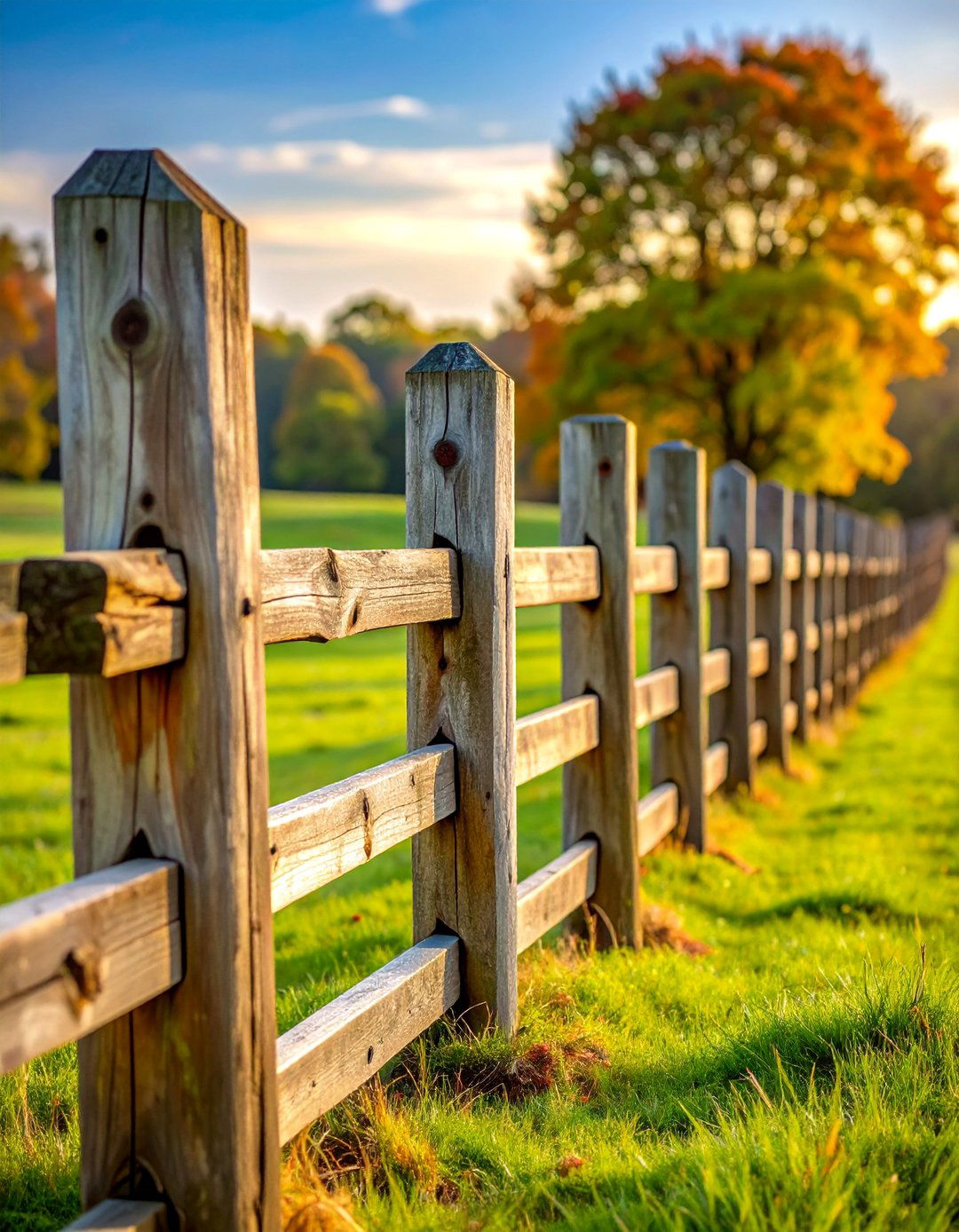
Split rail farm fences offer timeless rustic charm while providing effective property demarcation and livestock boundaries. These fences utilize horizontally-stacked wooden rails that fit into mortise-and-tenon joints or notched posts, creating the classic countryside aesthetic. The rails are typically made from hardwoods and split lengthwise into manageable pieces, then attached to vertical posts using traditional joinery methods. This fence style excels for larger properties where complete containment isn't critical, making it ideal for marking boundaries, containing horses, and enhancing rural property values. Installation requires minimal specialized equipment, though proper post spacing and rail selection significantly impact longevity and effectiveness.
2. High-Tensile Wire Farm Fence
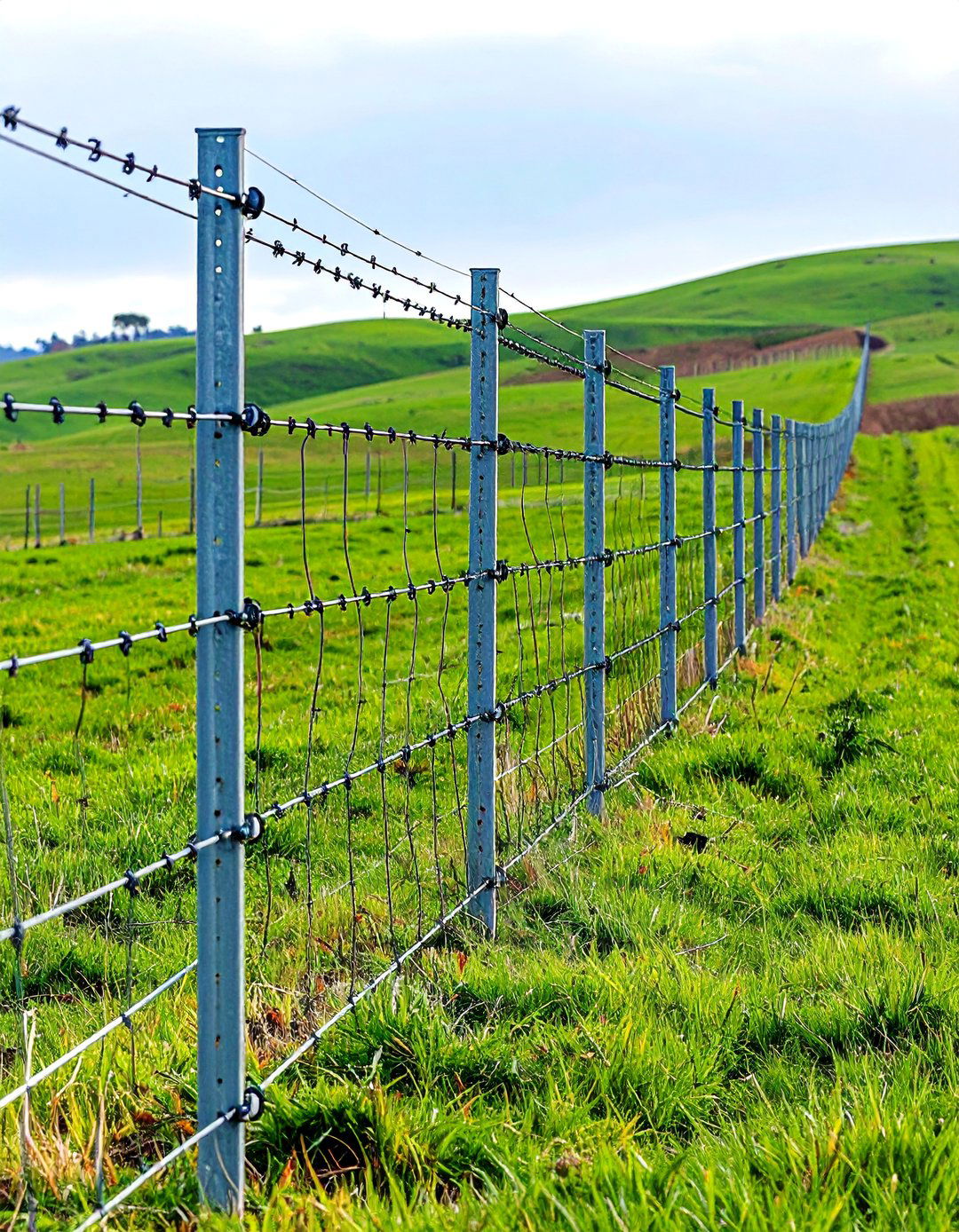
High-tensile wire farm fences provide exceptional strength and flexibility using fewer posts than traditional wire systems, reducing installation costs while maintaining security. This wire type delivers two and a half times more strength than mild steel while costing roughly the same amount. The tensioned wire system resists sagging and maintains consistent barrier height across varied terrain. These fences require retensioning at least once or twice yearly to maintain optimal performance. High-tensile farm fences work particularly well for cattle, sheep, and horses when combined with electric charging. The system's durability and low maintenance requirements make it cost-effective for large agricultural operations requiring extensive perimeter fencing.
3. Electric Farm Fence Systems
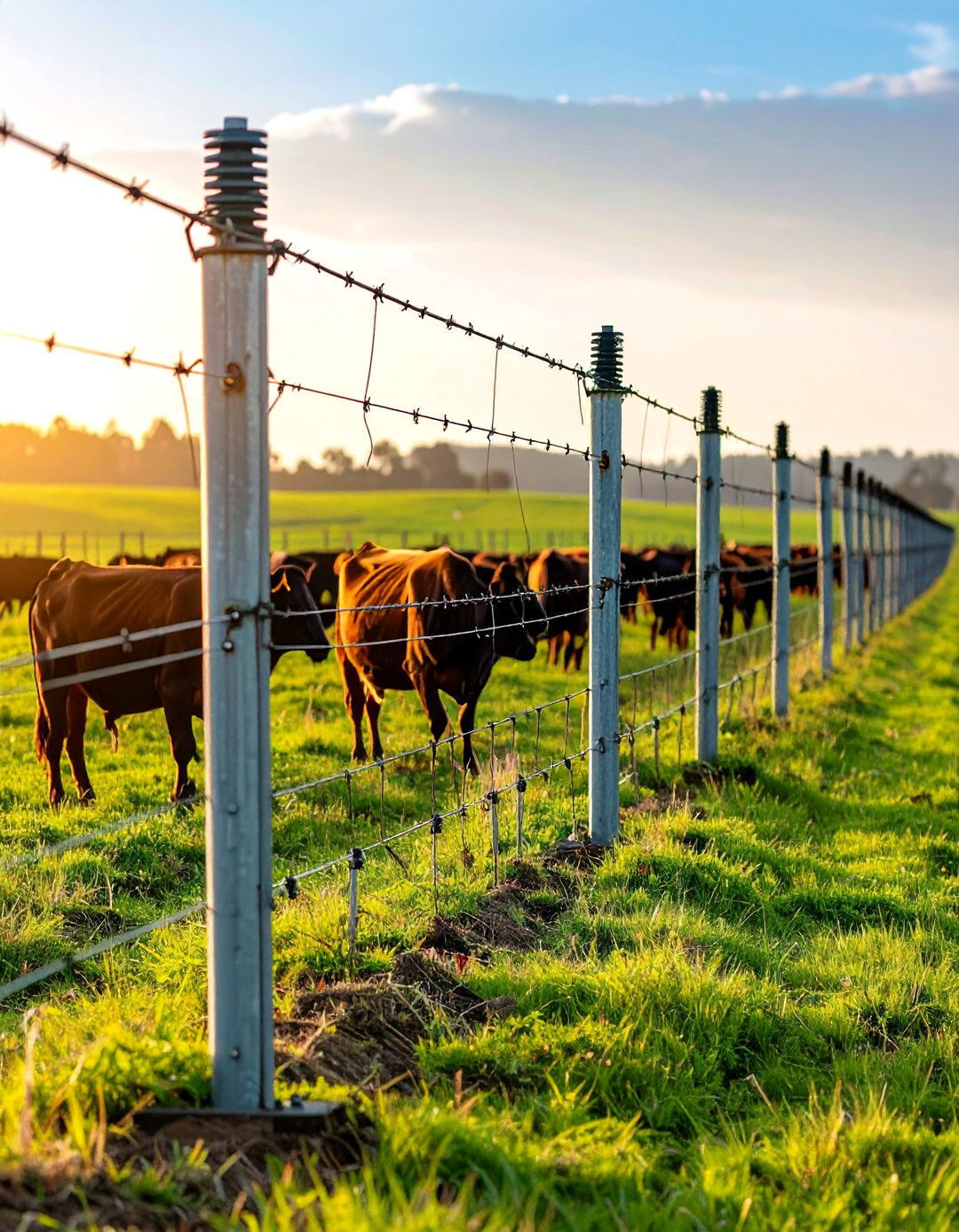
Electric farm fences deliver pulsed electrical current through energized wires, creating psychological and physical barriers that effectively contain livestock while deterring predators. This fencing method represents the fastest and most economical livestock containment solution, requiring fewer posts and easier installation than barbed wire alternatives. Modern electric systems can energize multiple miles of fencing with single energizers, with manufacturers typically recommending one joule per kilometer under ideal conditions. Smart electric fence systems now offer real-time monitoring through mobile apps, alerting farmers to voltage drops or breaches. Training animals to respect electric boundaries typically requires only one or two days of controlled exposure in smaller enclosures.
4. Woven Wire Farm Fence

Woven wire farm fences feature interlocking horizontal and vertical wires knotted together, creating strong barriers suitable for containing various livestock sizes while providing predator protection. These fences utilize high-strength galvanized steel wire with innovative designs, firm structures, and excellent corrosion resistance that can exceed twenty years of service life. The mesh pattern varies from tight spacing for smaller animals to wider openings for larger livestock. Woven wire effectively contains horses, cattle, sheep, goats, and deer while withstanding daily farm operations and weather variations. Installation requires proper tensioning and adequate corner bracing to prevent wire stretching. The initial investment costs more than simpler wire systems but provides superior long-term containment for mixed livestock operations.
5. Post and Rail Farm Fence
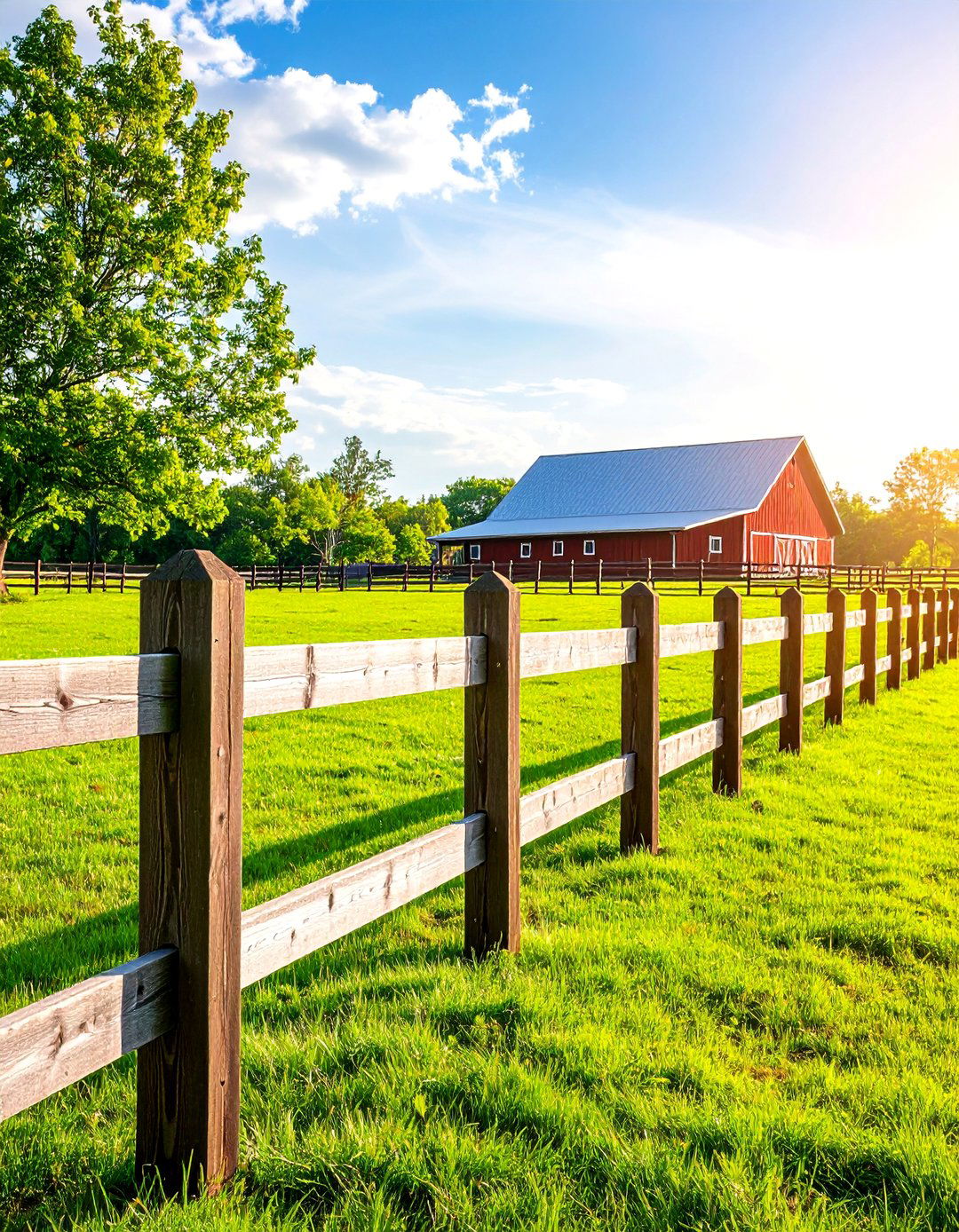
Post and rail farm fences combine vertical posts with horizontal rails, creating sturdy boundaries without obstructing views across agricultural landscapes. The traditional board fence design features posts spaced every eight feet with three or four horizontal boards running between them, creating elegant simplicity that functions as both art and practical containment. These fences work exceptionally well for horses and cattle, especially when combined with electric wire to minimize wear and prevent animals from leaning against the structure. Various wood types including cedar, pine, and pressure-treated lumber offer different durability and aesthetic options. Post and rail systems can be customized in multiple sizes and styles while providing reliable, safe containment for valuable livestock.
6. Barbed Wire Farm Fence

Barbed wire farm fences consist of steel wire strands twisted together with sharp barbs spaced every four to five inches, providing cost-effective livestock containment across large areas. This fencing innovation, first patented in 1867, revolutionized agricultural boundaries by making large-scale livestock management practical and affordable. The psychological deterrent effect keeps docile animals like cattle away from fence lines while providing physical barriers against escape attempts. Installation typically uses three to five strands mounted on wooden or metal posts with proper tensioning systems. Barbed wire costs significantly less than alternatives but requires careful consideration for horse operations due to injury risks from entanglement. Regular maintenance includes checking wire tension and replacing damaged sections promptly.
7. Welded Wire Farm Fence

Welded wire farm fences create grid patterns through vertical and horizontal wires welded at intersection points, forming rigid mesh structures ideal for smaller livestock containment. While less sturdy than woven wire alternatives, welded wire excels for containing chickens and other poultry that don't lean against fence lines. This fence type works well for marking property boundaries and containing dogs or sheep, particularly effective on flat terrain. The rigid construction prevents mesh deformation but may be more susceptible to impact damage than flexible alternatives. Combined with wooden frames, welded wire creates attractive residential-style boundaries while maintaining agricultural functionality. Various mesh sizes accommodate different animal types, from fine chicken wire to larger livestock applications with appropriate post spacing and support systems.
8. PVC Vinyl Farm Fence
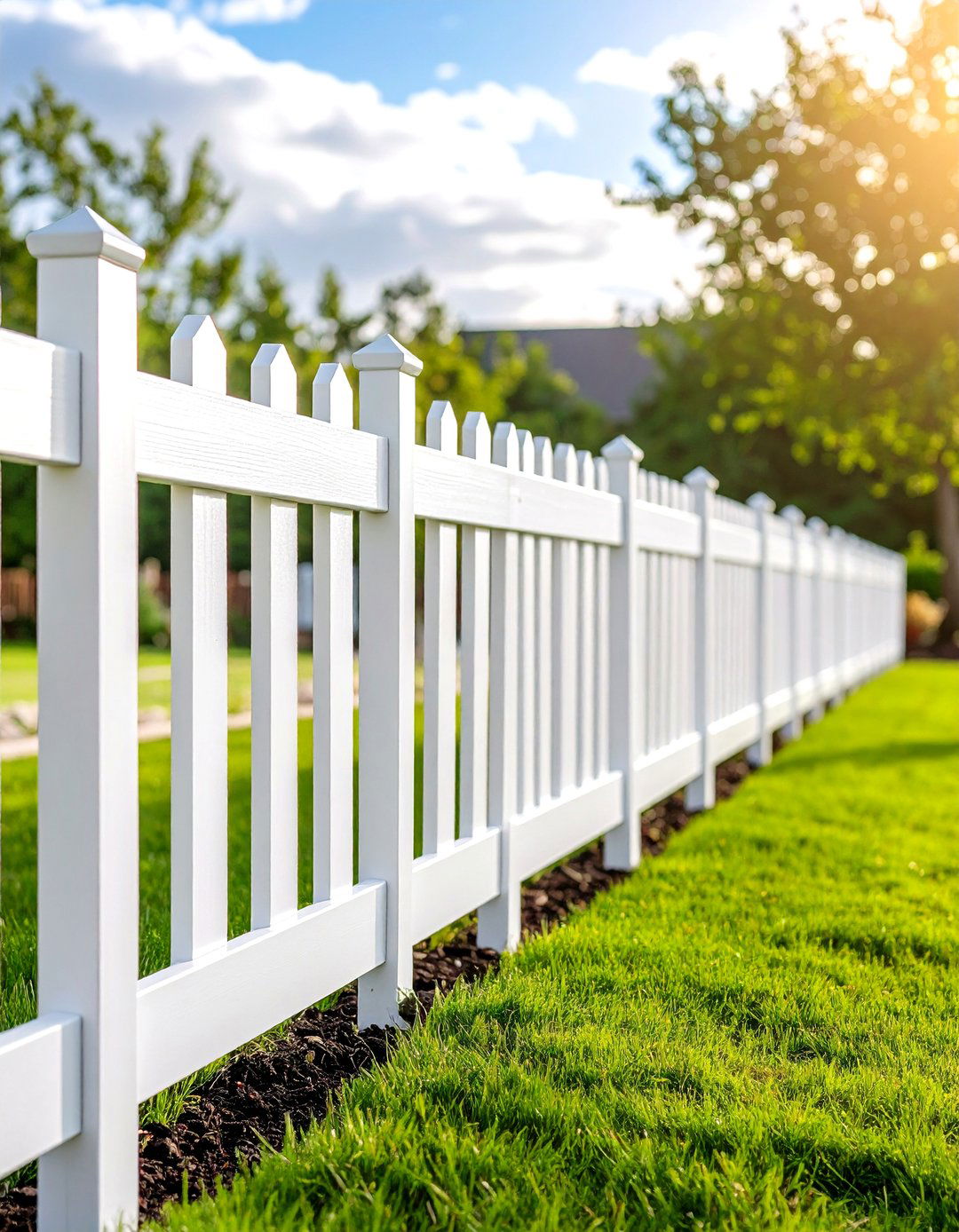
PVC vinyl farm fences offer low-maintenance durability with customizable colors and styles, providing cost-effective alternatives to traditional wood while resisting rot, insects, and weather damage. Modern vinyl fencing incorporates titanium dioxide and UV stabilizers during manufacturing, greatly improving durability and preventing premature aging from sun exposure. Split rail vinyl designs bring modern efficiency to classic ranch aesthetics, requiring no staining or regular maintenance beyond occasional cleaning. Vinyl fencing flexes under impact and returns to original shape, making it safer for livestock than rigid alternatives while maintaining strength over decades. Installation involves setting posts in concrete and inserting rails into pre-designed slots. These systems cost more initially than wood but provide long-term savings through reduced maintenance requirements and extended lifespan.
9. Crossbuck Horse Farm Fence
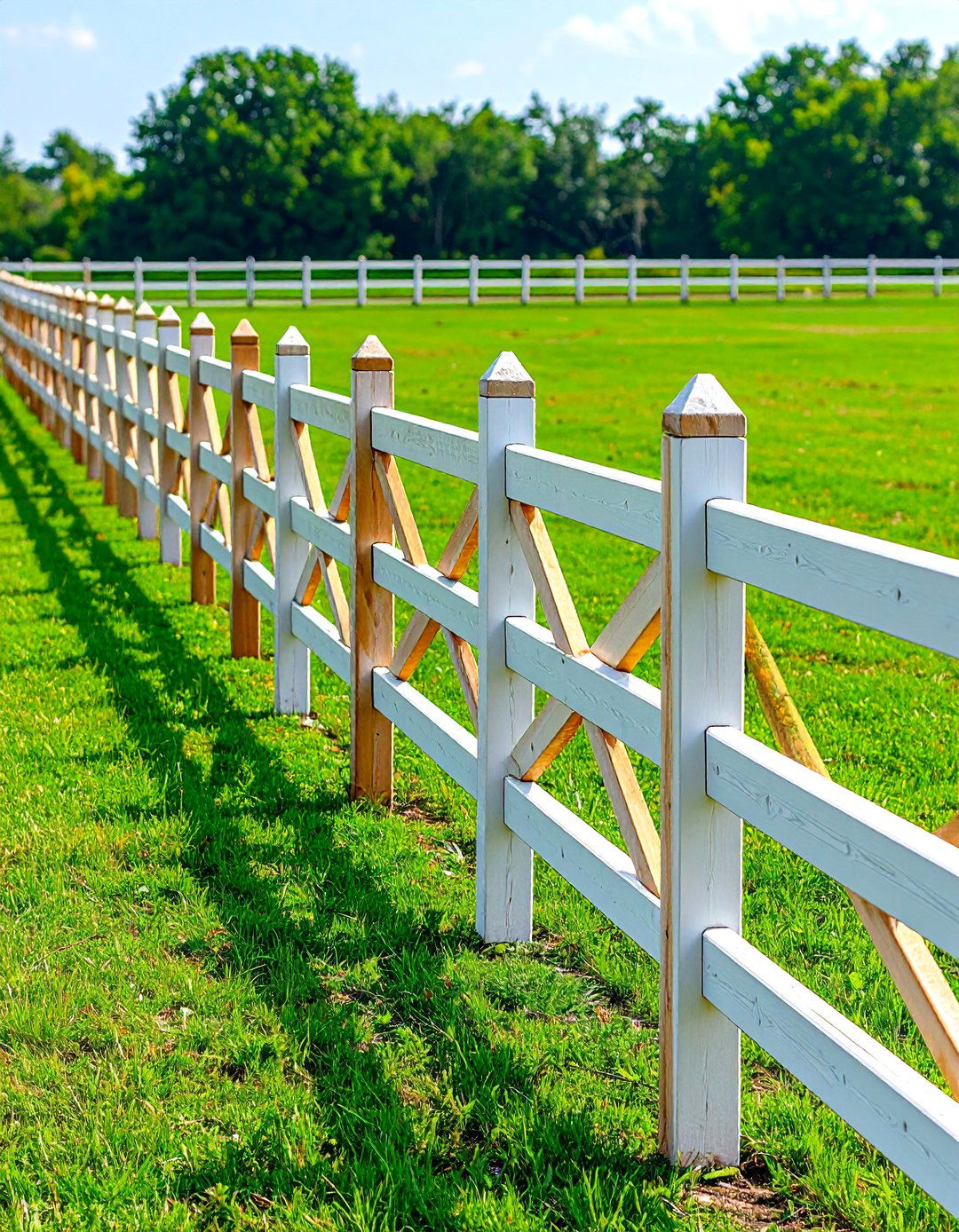
Crossbuck horse farm fences feature distinctive X-pattern designs between posts, providing excellent strength and safety specifically engineered for equestrian applications. The signature crossing pattern creates both functional support and aesthetic appeal while allowing easy visibility across farm properties for simplified livestock monitoring. This fence style requires less maintenance than solid board alternatives while providing adequate strength for horse containment. The open design permits air circulation and maintains sight lines that help prevent panic in confined horses. Installation involves setting sturdy posts with diagonal braces forming the characteristic X-pattern between uprights. Many farmers prefer crossbuck designs because they combine functionality with visual appeal while offering practical advantages for active horse operations. The style works particularly well around paddocks, training areas, and property perimeters where both safety and aesthetics matter.
10. Round Rail Wood Farm Fence
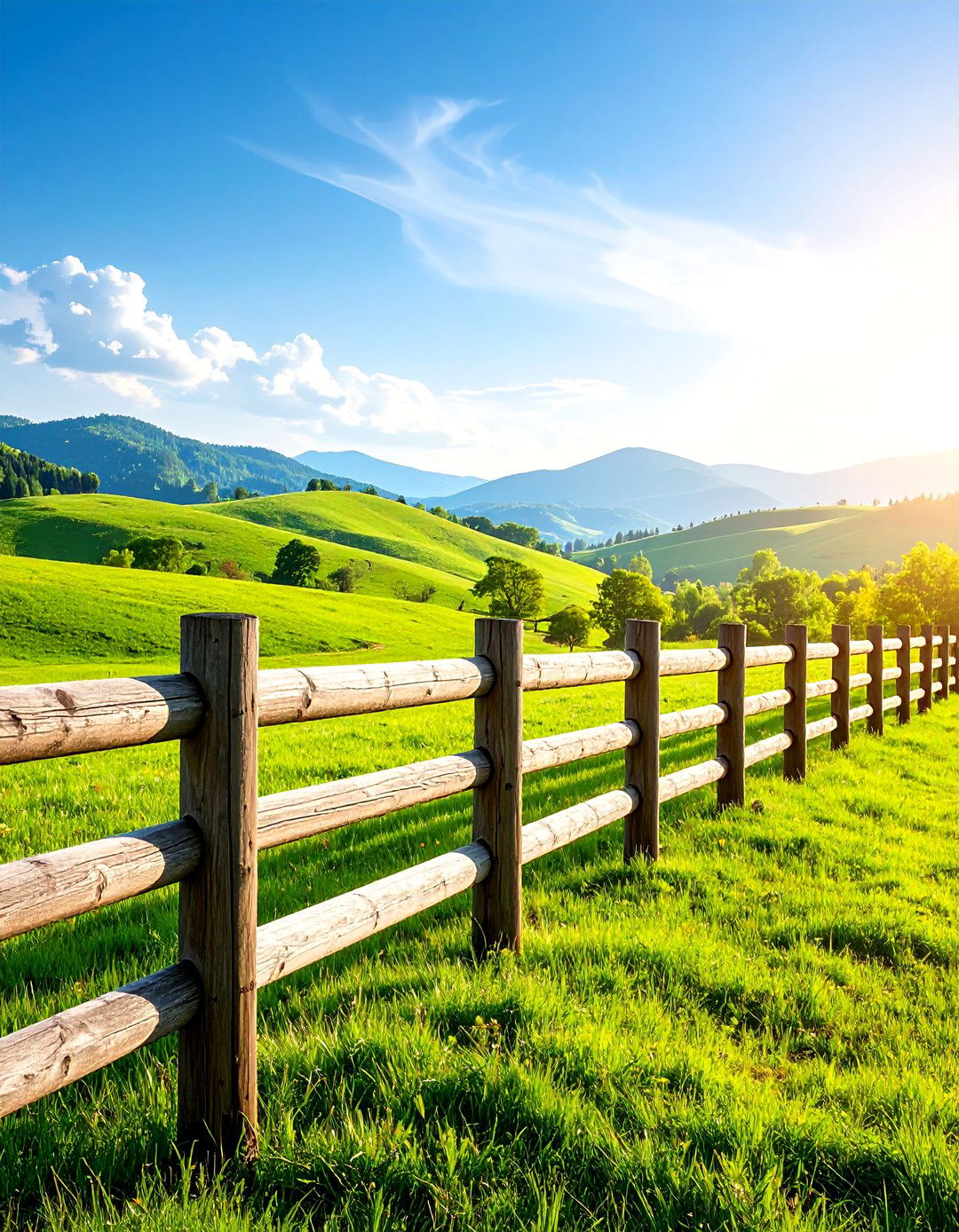
Round rail wood farm fences utilize naturally round or shaped timber rails attached to vertical posts, providing smooth surfaces that enhance safety while maintaining rustic agricultural aesthetics. The natural round shape makes these rails less prone to cracking or splitting compared to flat alternatives, while larger diameters provide greater strength and stability. These fences offer polished appearances that enhance overall farm aesthetics while defining property lines and containing livestock effectively. Rails typically span eight to ten feet between posts using various attachment methods including drilling holes through posts for rail insertion. Round rail systems have been professionally installed since 2006 using locally-sourced materials, ensuring quality construction and supporting regional economies. The smooth surfaces reduce injury risks for animals while providing long-lasting boundaries that complement natural landscapes beautifully.
11. Board Paddock Farm Fence
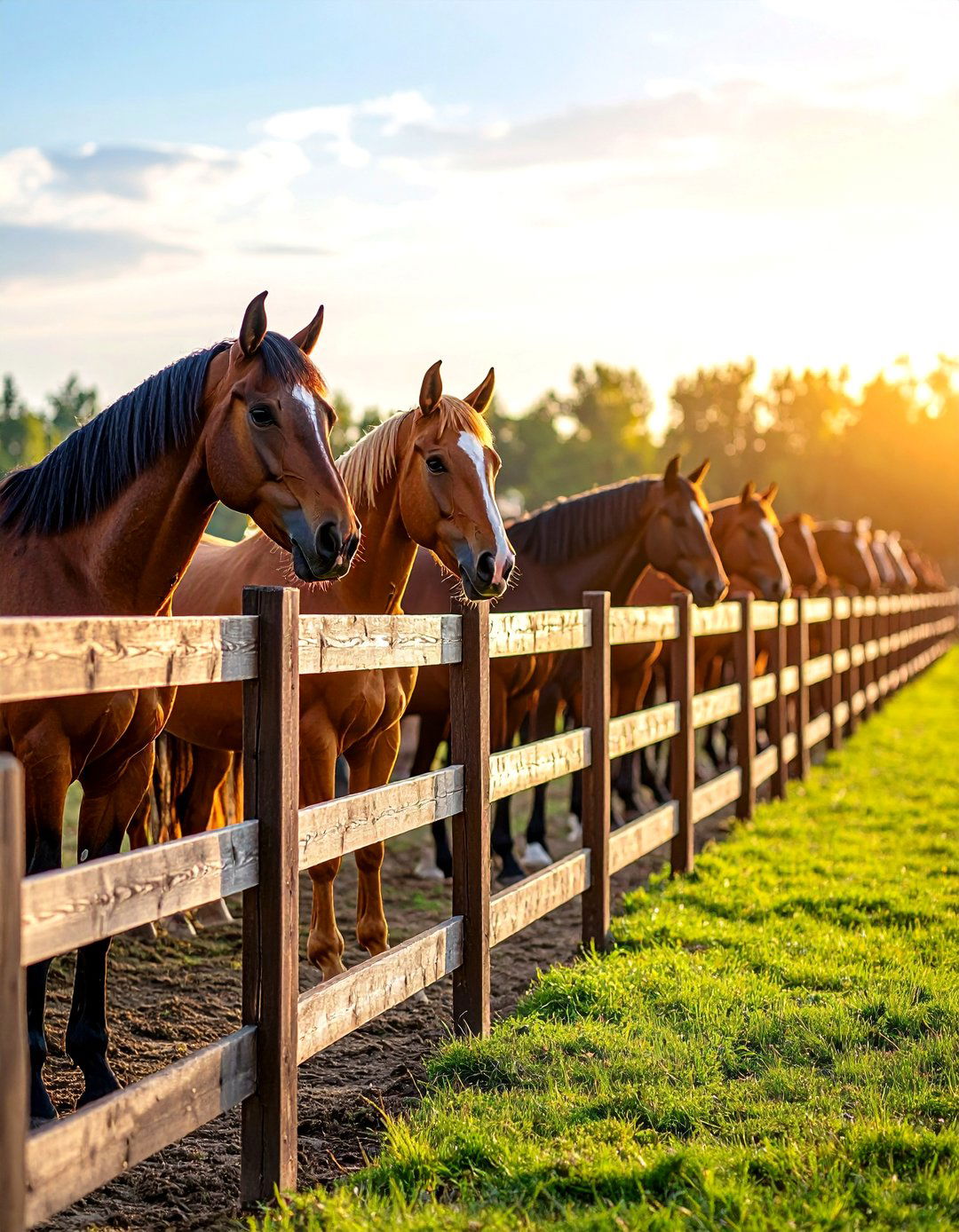
Board paddock farm fences consist of horizontal wooden boards in three or four-rail configurations, creating neat, orderly appearances while effectively containing livestock, especially horses. These fences are particularly popular on horse farms housing expensive show animals, offering both safety and aesthetic appeal around farm buildings and residential areas. Traditional paddock designs prioritize both functionality and visual appeal, requiring regular inspections and maintenance to address wear while ensuring structural integrity. Various wood options include pressure-treated pine, cedar, redwood, and painted alternatives, each offering different cost points and durability characteristics. Modern paddock fencing includes PVC plastic and vinyl-coated wooden boards, though these cost more than traditional wood while offering reduced maintenance. Installation requires precise post alignment and proper board attachment for professional appearance and long-term stability.
12. Cable Wire Farm Fence

Cable wire farm fences utilize smooth steel cables stretched between anchor posts, with each cable typically made from seven wire strands twisted together for maximum strength. Heavy springs at one end absorb shock loads while the opposite end attaches rigidly to anchor posts, with cables passing through holes in wooden line posts. This system accommodates various cable numbers depending on containment requirements, though six-cable configurations are common for livestock applications. Due to higher costs, cable fences primarily serve confinement areas such as holding pens, feedlots, and corrals where maximum strength is essential. The flexible nature allows cables to absorb animal impact without structural failure. Installation requires substantial anchor posts with proper bracing to handle cable tension loads. Regular maintenance includes checking cable tension, spring condition, and attachment point integrity for optimal performance and safety.
13. Mesh Diamond Farm Fence
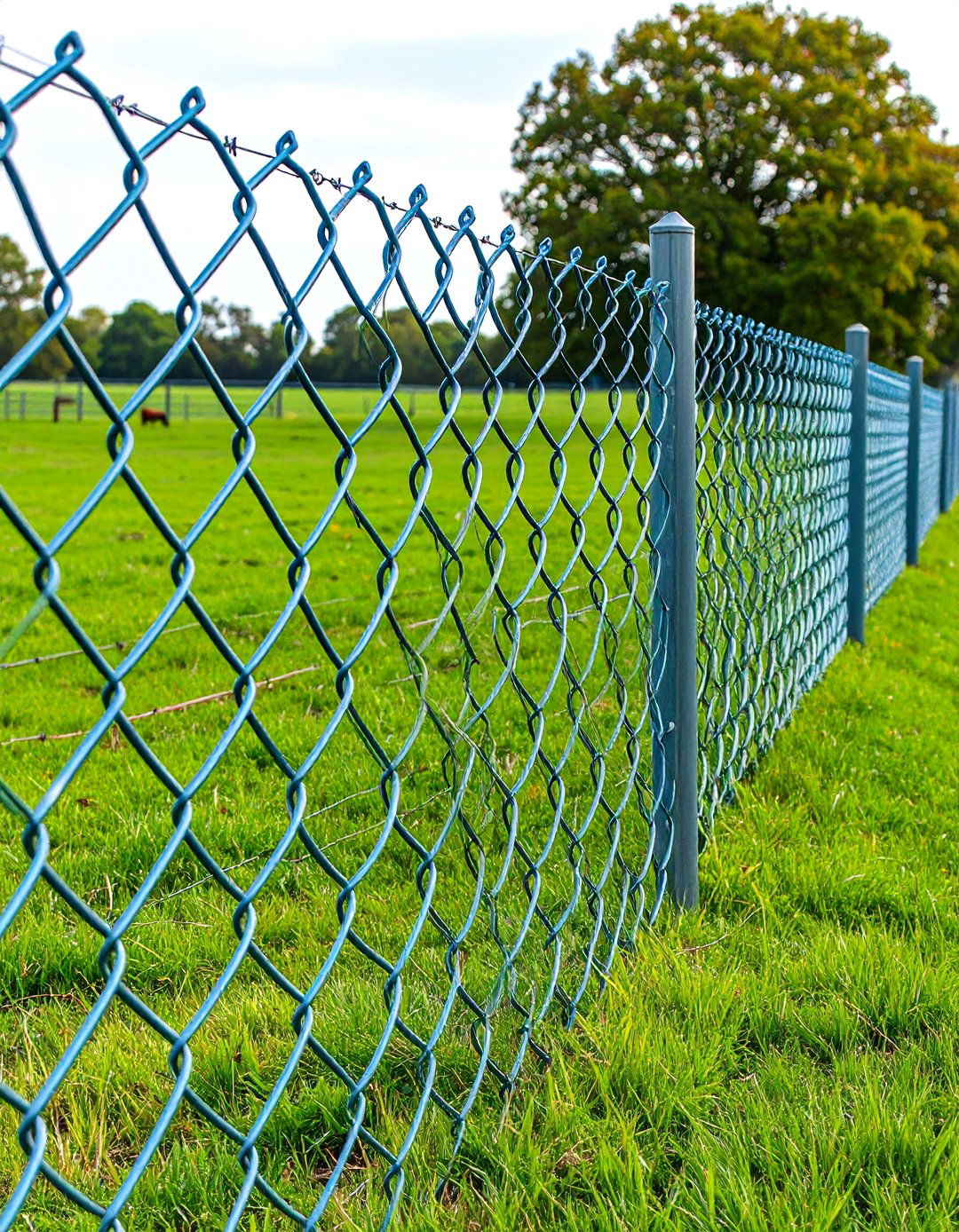
Mesh diamond farm fences feature two wires twisted together in diamond formations, creating strong yet flexible barriers ideal for livestock containment and predator exclusion. These expensive but effective systems work particularly well for valuable horses due to small openings that prevent hoof entanglement and eliminate sharp wire ends that could cause injury. The diamond pattern provides excellent visibility while maintaining structural integrity under livestock pressure. Diamond mesh designs offer safe, secure, durable, and attractive horse fencing solutions with high tensile galvanized steel construction. Installation requires careful attention to post spacing and proper tensioning to maintain diamond shape integrity. This fence type serves excellently for large area applications containing valuable animals where safety and security justify higher initial investments. The flexible mesh construction adapts to terrain variations while providing consistent containment effectiveness across varied landscape conditions.
14. Graduated Spacing Farm Fence
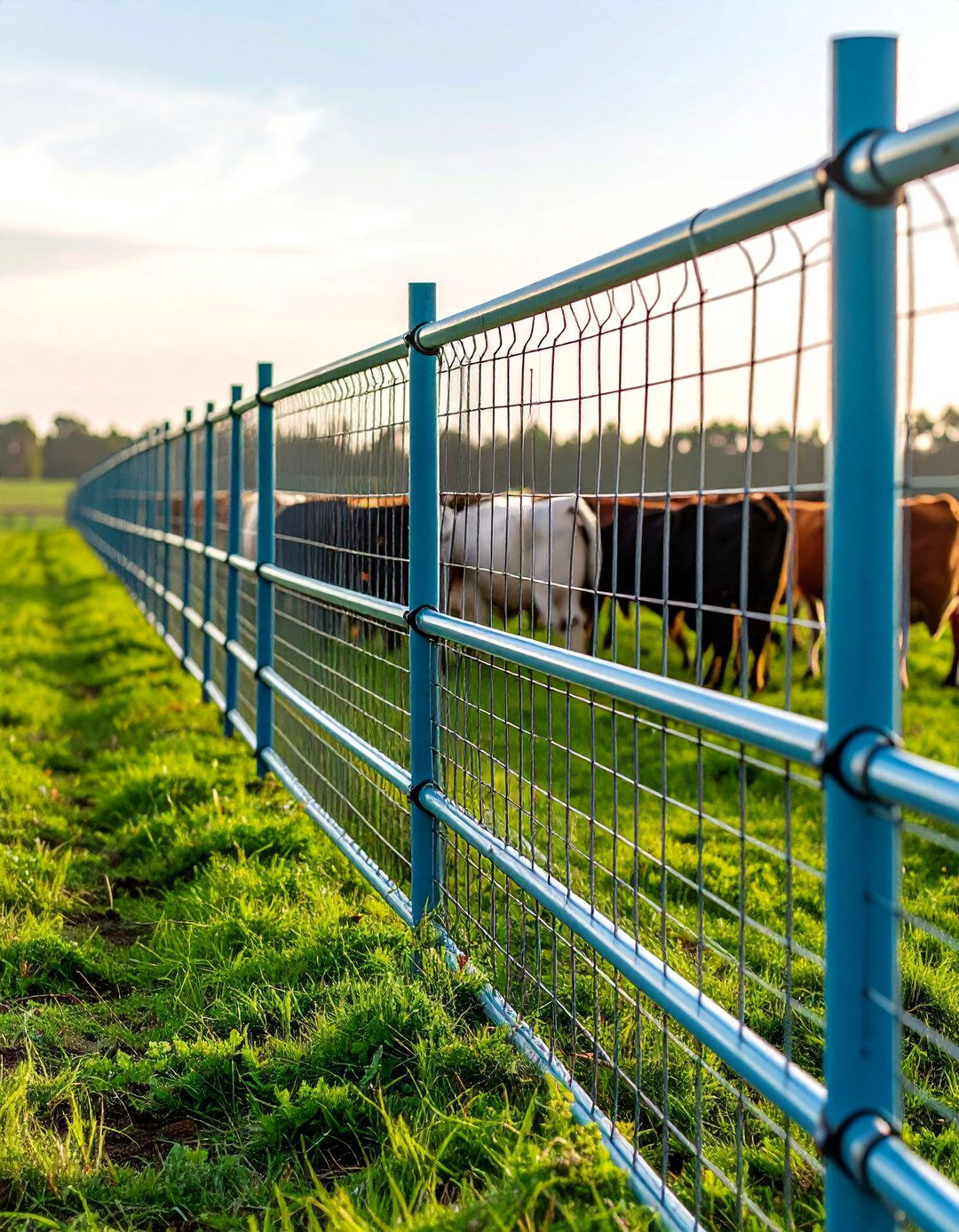
Graduated spacing farm fences feature mesh with small openings at the bottom transitioning to larger openings at the top, effectively containing various animal sizes within single fence systems. This unique structure keeps both small and large animals secure while providing cost-effective solutions for mixed livestock operations. The graduated design prevents small animals from escaping through bottom sections while allowing adequate spacing above for larger livestock comfort. Wire field fences with graduated openings represent popular deer fencing materials due to their versatility and effectiveness. These fences utilize high-tensile galvanized steel wires with various knot styles including hinged joints and fixed knots for different strength requirements. Installation involves proper post spacing and tensioning to maintain graduated pattern integrity. The design particularly suits operations with multiple animal types requiring different containment approaches within unified fencing systems.
15. T-Post Temporary Farm Fence
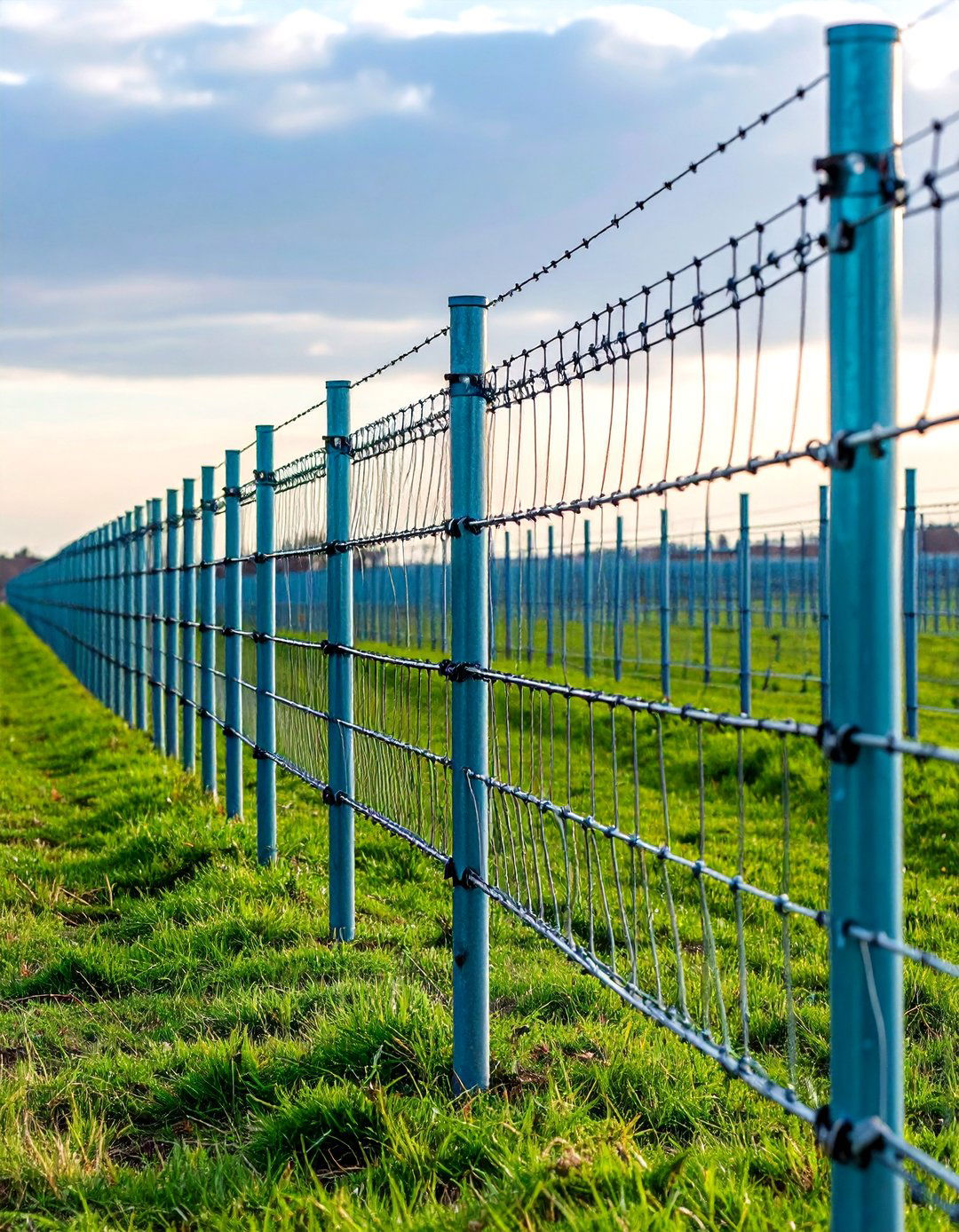
T-post temporary farm fences provide quick, budget-friendly solutions for short-term livestock containment using metal T-shaped posts with attached wire or mesh materials. These fences typically run four to eight feet in height and move easily whenever temporary enclosure needs change. The lightweight construction allows rapid installation and removal without specialized equipment or extensive ground preparation. While less aesthetically pleasing than permanent alternatives, T-post systems offer practical solutions for rotational grazing, temporary paddocks, and emergency repairs. Various wire types including barbed wire, woven wire, and electric options attach to T-posts using clips or insulators. Installation involves driving posts into ground at appropriate spacing and attaching chosen wire materials. Regular inspections ensure posts remain secure and wire attachments maintain proper tension for effective containment.
16. Synthetic Composite Farm Fence

Synthetic composite farm fences utilize advanced materials combining heavy synthetic strapping with internal cables, synthetic-coated high-tensile wire, or protective coatings over traditional rail materials. Composite materials provide serious strength often exceeding wood performance while offering maintenance-free operation throughout extended service life. These materials resist discoloration and weathering so effectively that manufacturers offer decades-long to lifetime warranties. Various profiles accommodate different aesthetic preferences from traditional wood appearance to modern clean lines. Installation methods vary by specific product design but generally involve standard post-setting procedures with manufacturer-specific attachment systems. Synthetic fences cost more initially but provide long-term value through durability and reduced maintenance compared to traditional materials. The environmental resistance makes composite fencing ideal for harsh climate conditions where traditional materials deteriorate rapidly, ensuring consistent performance across diverse agricultural environments.
17. Chain Link Farm Fence
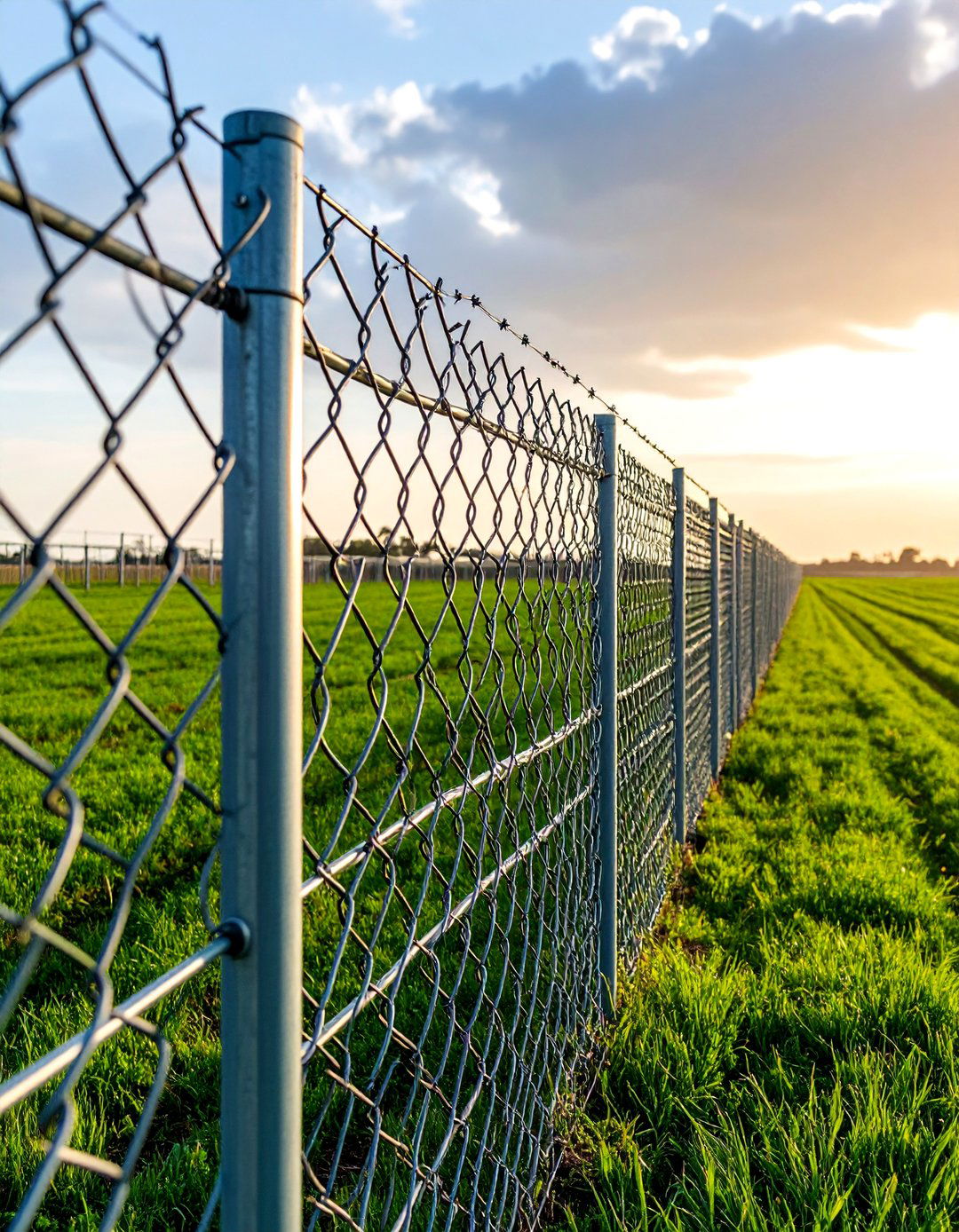
Chain link farm fences provide affordable solutions for containing large numbers of animals using galvanized or coated steel construction that offers durability and easy maintenance. This fence type proves quite durable and simple to maintain, making it ideal for farms requiring long-term containment solutions. The woven mesh pattern allows visibility while preventing animal escape and unauthorized entry. Various heights and mesh sizes accommodate different livestock types and security requirements. Chain link represents the most common and cost-effective wire fence option, utilizing galvanized steel wires woven together for strong barrier formation. Installation requires setting line posts at appropriate spacing with tensioning systems to maintain mesh integrity. The relatively inexpensive installation and maintenance costs make chain link attractive for budget-conscious operations requiring extensive perimeter fencing. Regular maintenance involves checking post stability and mesh condition while addressing any damage promptly.
18. Stone Wall Farm Fence

Stone wall farm fences represent traditional boundary markers created from stones removed from agricultural fields, serving dual purposes of field clearing and livestock containment. These charming walls found throughout New England countryside demonstrate labor-intensive construction methods that repurposed necessary field stones into functional property boundaries. The dry-stack construction requires no mortar while providing permanent boundaries that last centuries with minimal maintenance. Stone walls effectively marked property lines and contained livestock in areas with abundant natural stone resources. Construction involves careful stone selection and placement to ensure stability and appropriate height for intended livestock. While labor-intensive initially, stone walls provide virtually maintenance-free operation after completion. The natural appearance integrates seamlessly with rural landscapes while providing wildlife habitat and historical character. Modern applications may combine stone walls with wire additions for enhanced containment of smaller animals.
19. Combination Wire and Wood Farm Fence
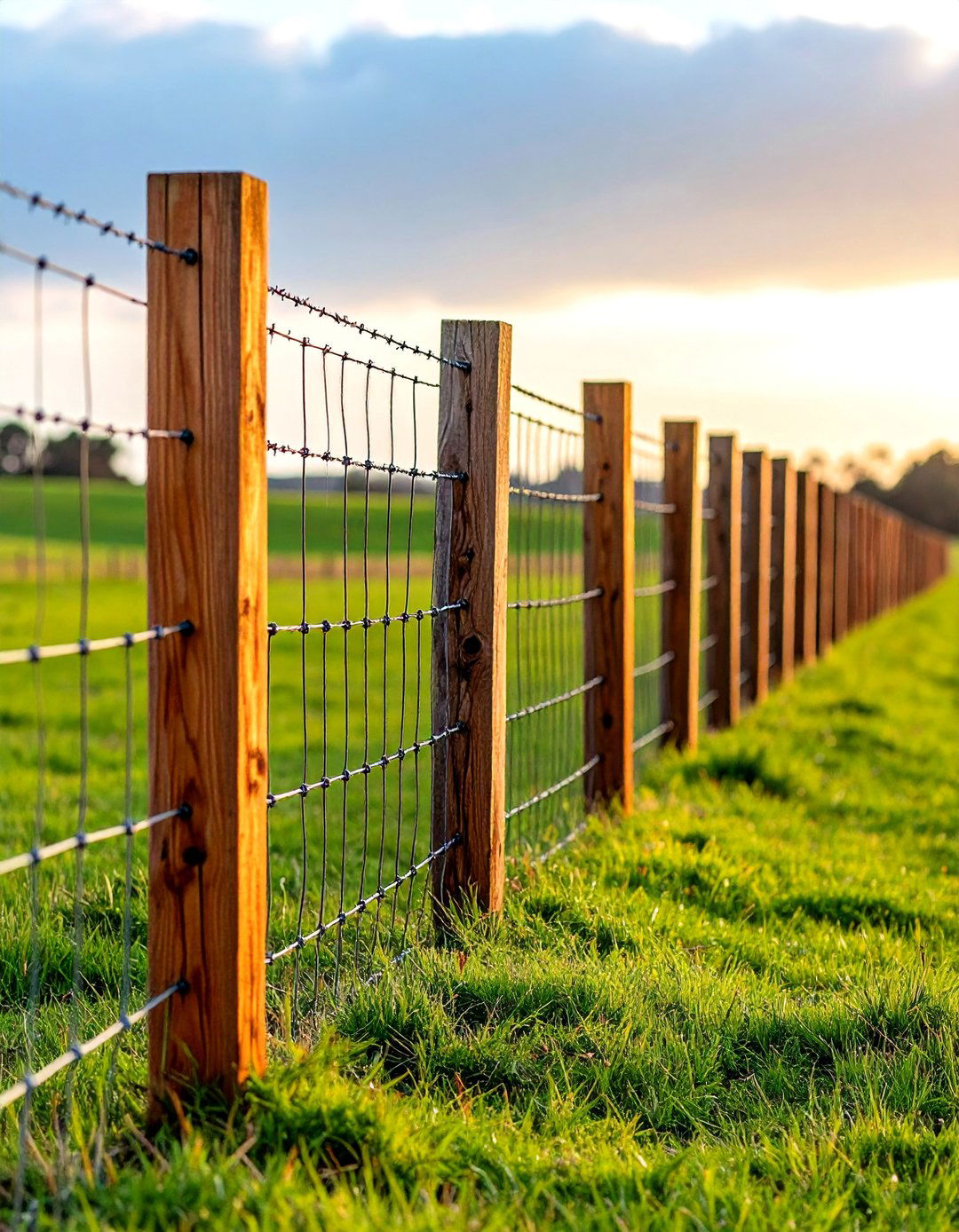
Combination wire and wood farm fences merge wooden posts with welded wire panels, creating secure, versatile options that balance traditional aesthetics with modern durability. Wire mesh attachments to wooden rail systems provide enhanced containment for pets and small animals while maintaining fence line visibility and traditional appearance. This hybrid approach allows customization for specific livestock needs while managing costs effectively. Combining materials like metal fences with wooden posts reduces overall costs while maximizing functional benefits of each component. The wood framework provides structural support and aesthetic appeal while wire additions handle detailed containment requirements. Installation involves standard wooden fence construction with wire mesh attachment using appropriate fasteners. Many farm fence designs can accommodate wire additions to keep smaller animals contained while maintaining the primary structure's appearance and function. Regular maintenance includes treating wood components and checking wire attachment integrity.
20. Smart Electric Farm Fence

Smart electric farm fences incorporate advanced monitoring technology with real-time fence diagnostics, mobile app integration, and automated alert systems for comprehensive livestock management. These systems eliminate daily manual fence checks by providing instant notifications about voltage drops, battery status, and potential breaches through smartphone applications. Mobile app functionality allows remote fence monitoring and management from anywhere on the property while displaying comprehensive performance data and historical trends. Solar-powered energizers with battery backup ensure consistent operation during extended cloudy periods. Smart fence technology enables proactive problem resolution before issues become major containment failures, allowing farmers to focus on other agricultural tasks. Installation requires traditional electric fence setup with added smart monitoring components and wireless connectivity. The technology represents significant advancement in agricultural automation, providing peace of mind through constant system surveillance and immediate problem notification for optimal livestock security.
Conclusion:
Selecting appropriate farm fence solutions requires careful consideration of livestock types, property characteristics, budget constraints, and long-term maintenance capabilities. From traditional split rail aesthetics to cutting-edge smart electric systems, modern agricultural fencing offers diverse options to meet every farming operation's unique requirements. Whether prioritizing cost-effectiveness, durability, safety, or technological integration, the twenty farm fence ideas presented provide comprehensive solutions for effective livestock management, property protection, and agricultural success across varied farming environments and operational scales.


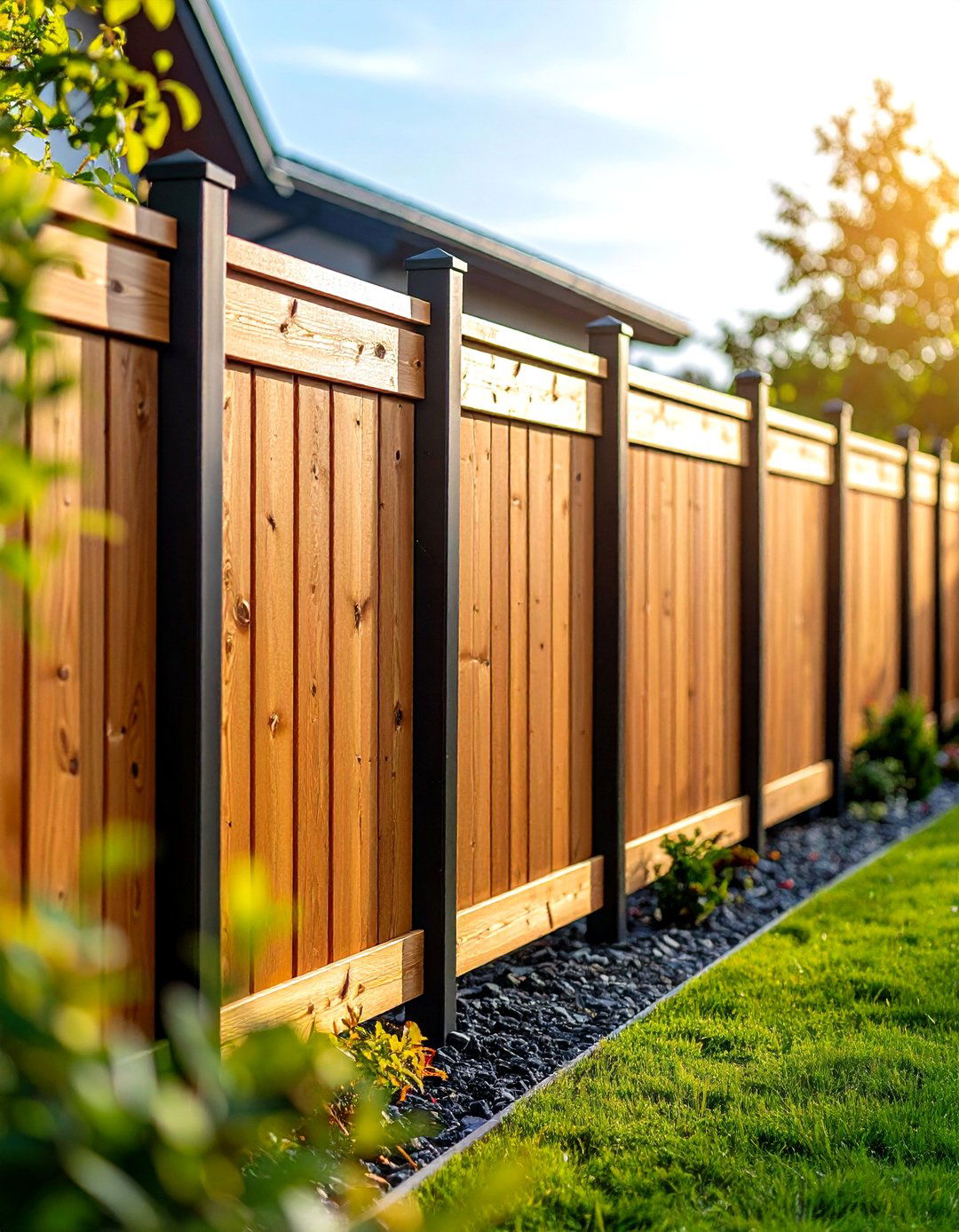
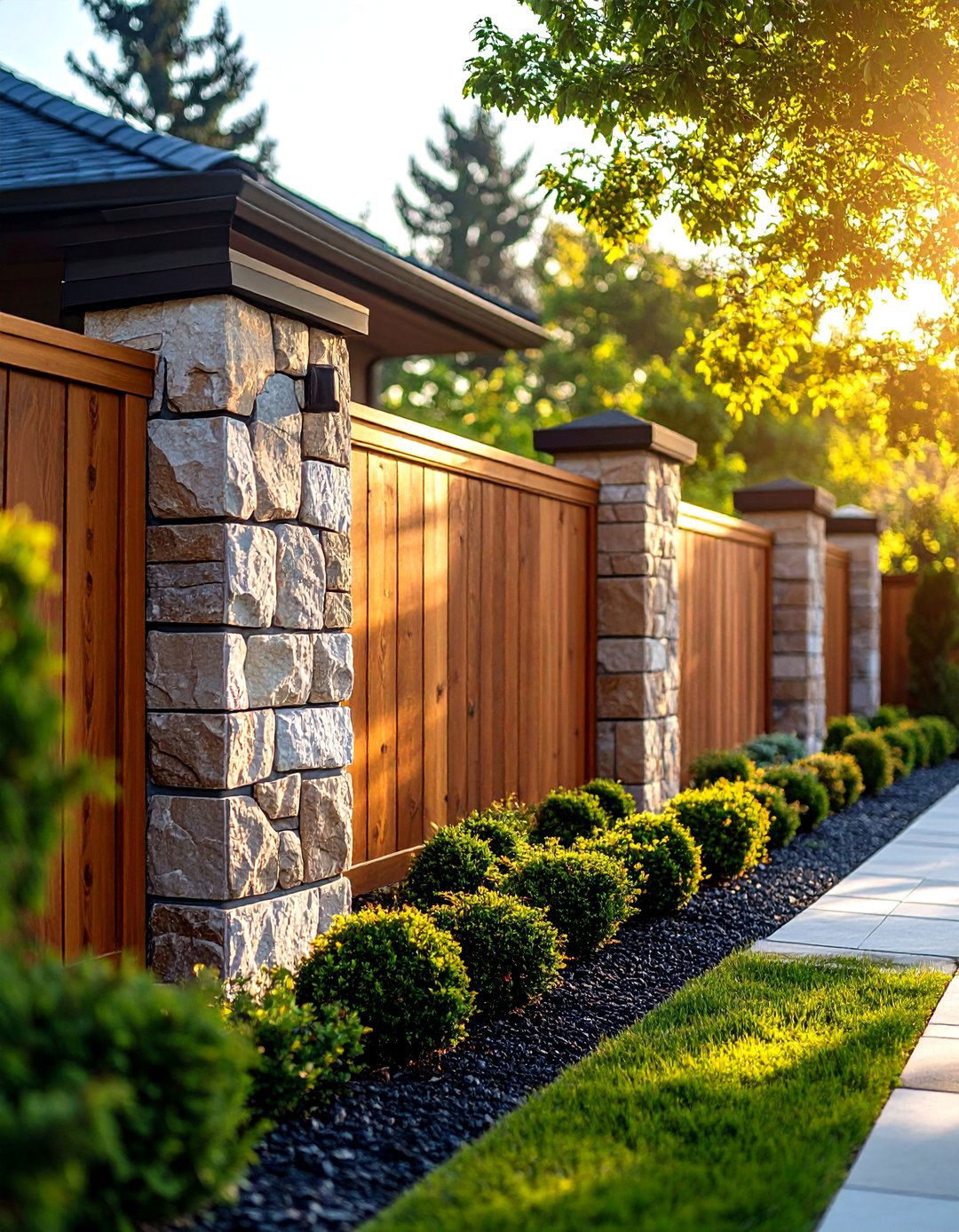
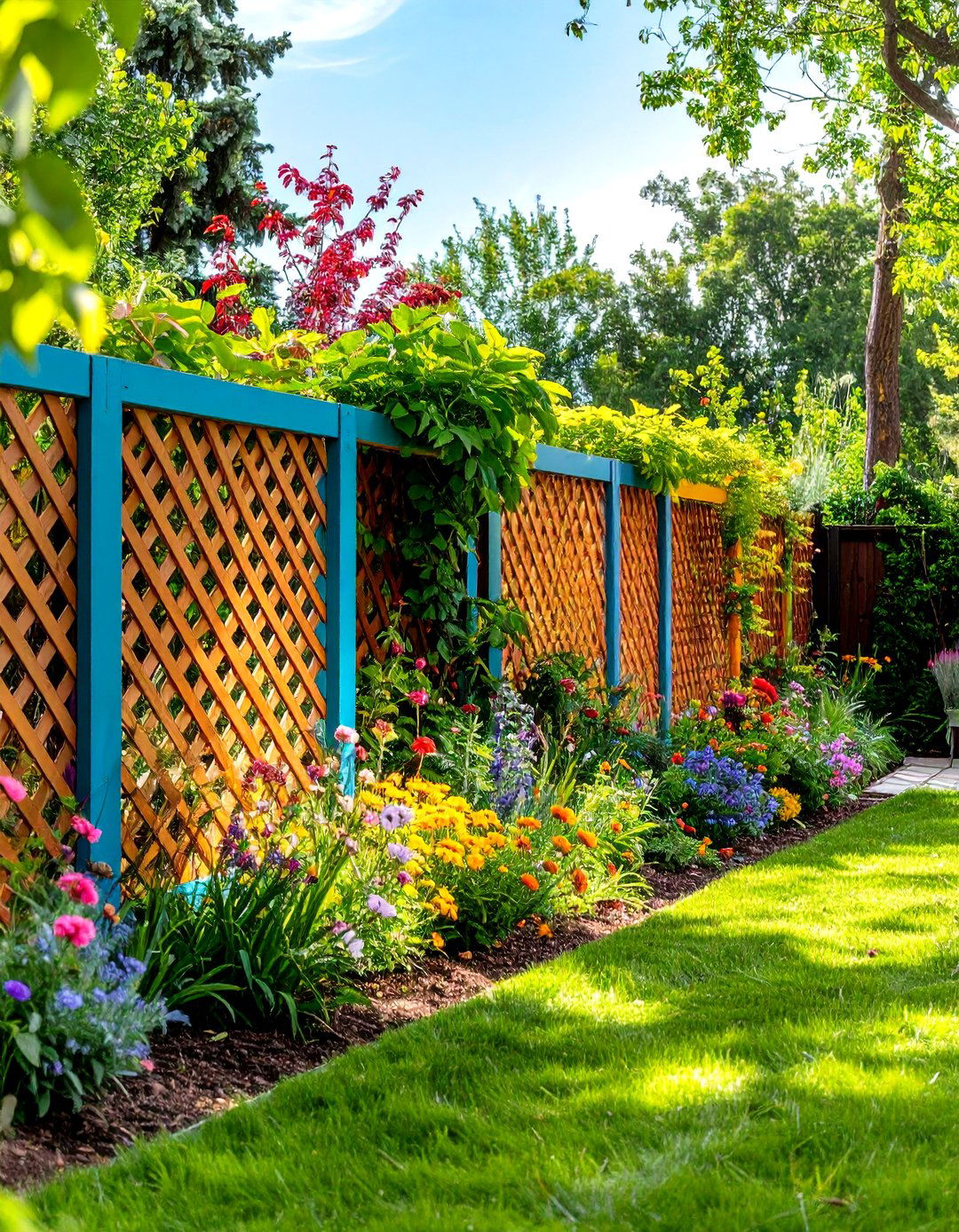
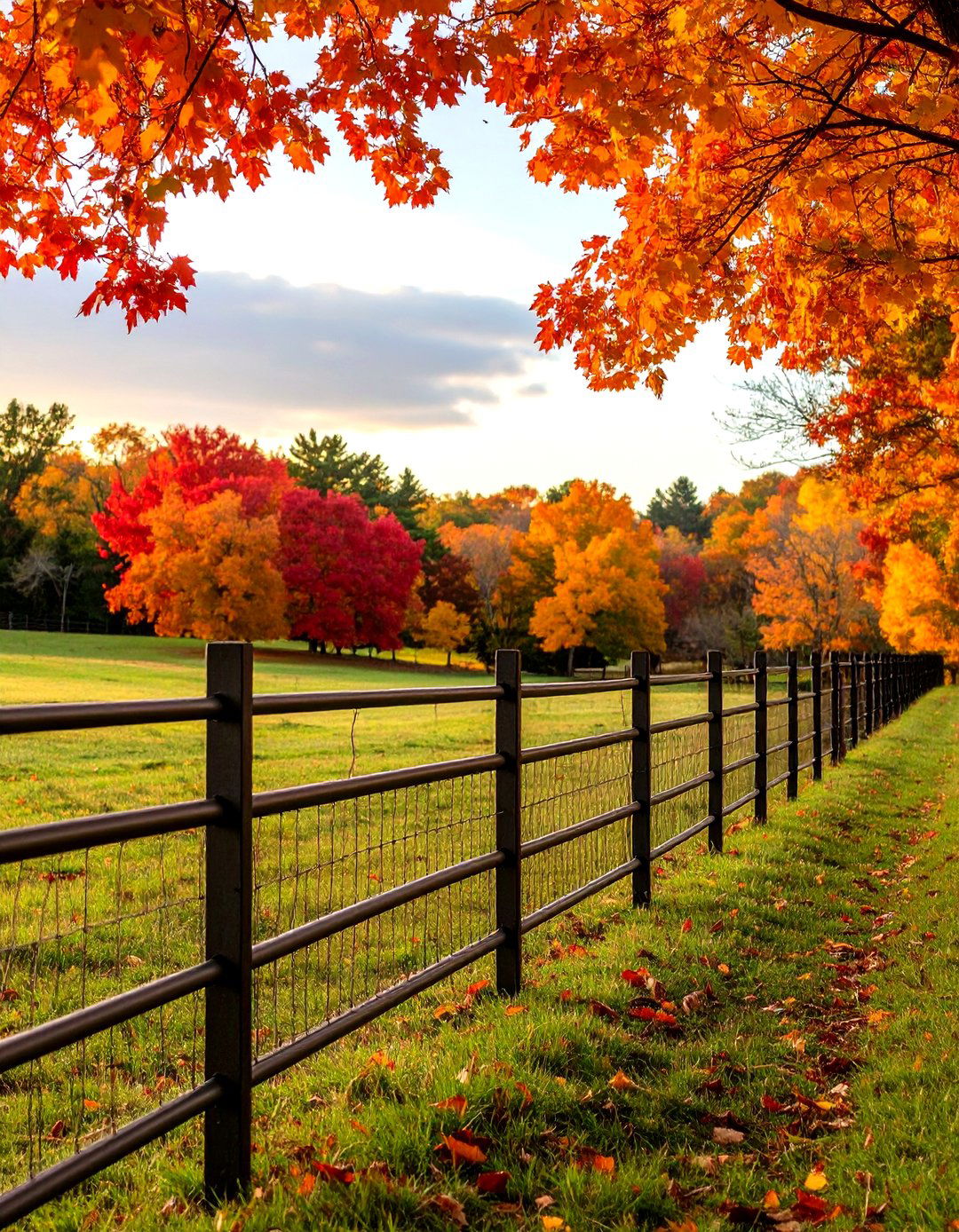
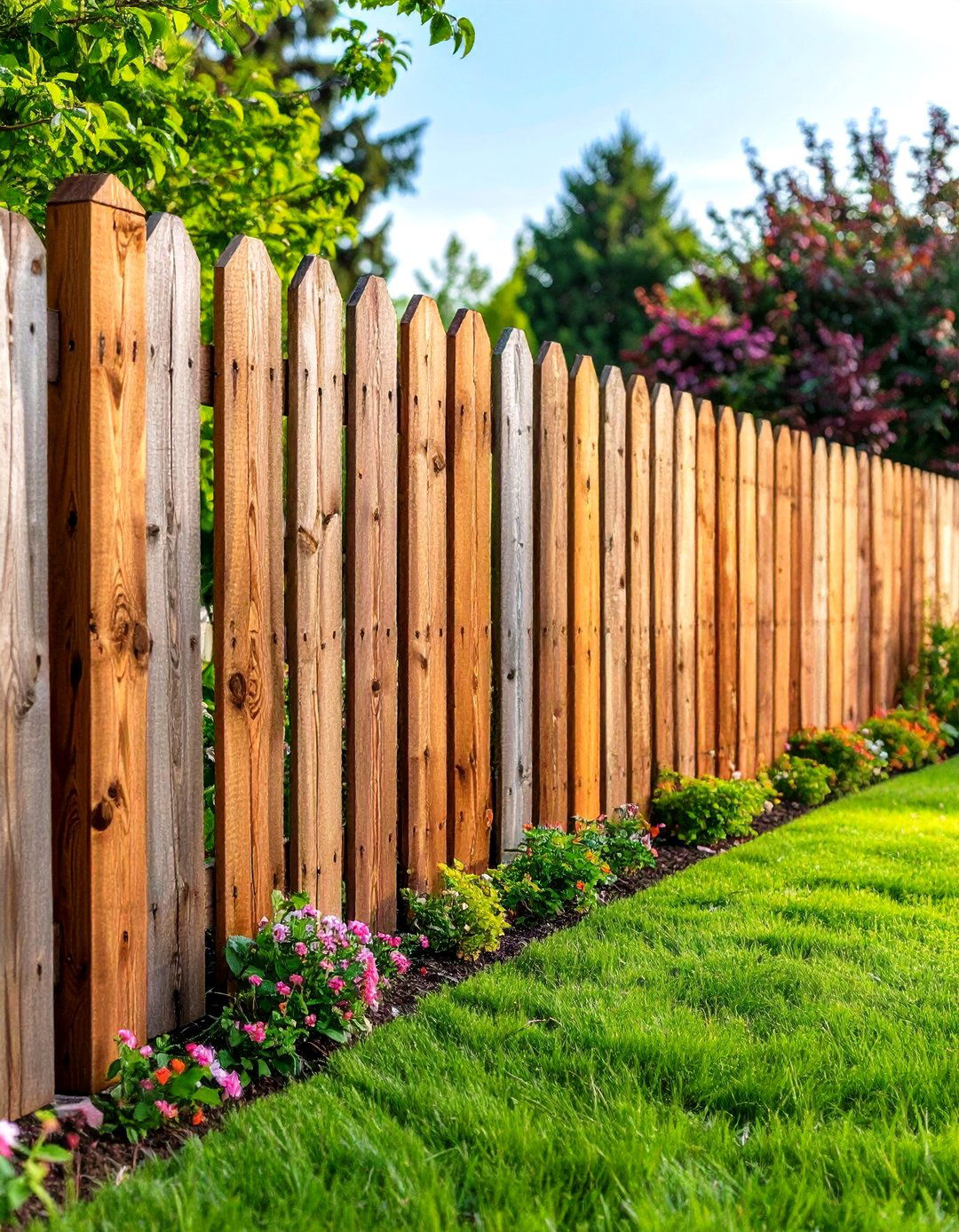


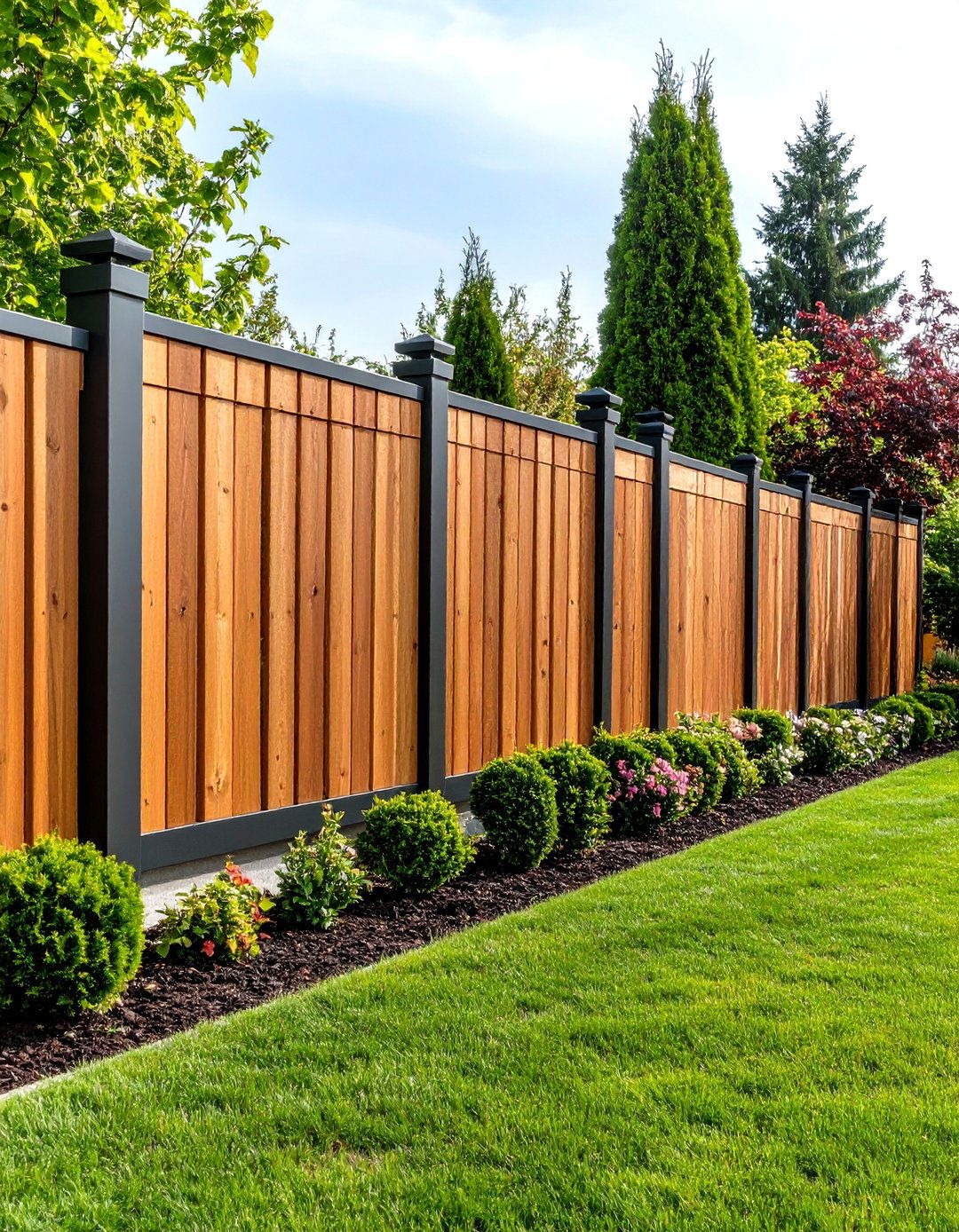
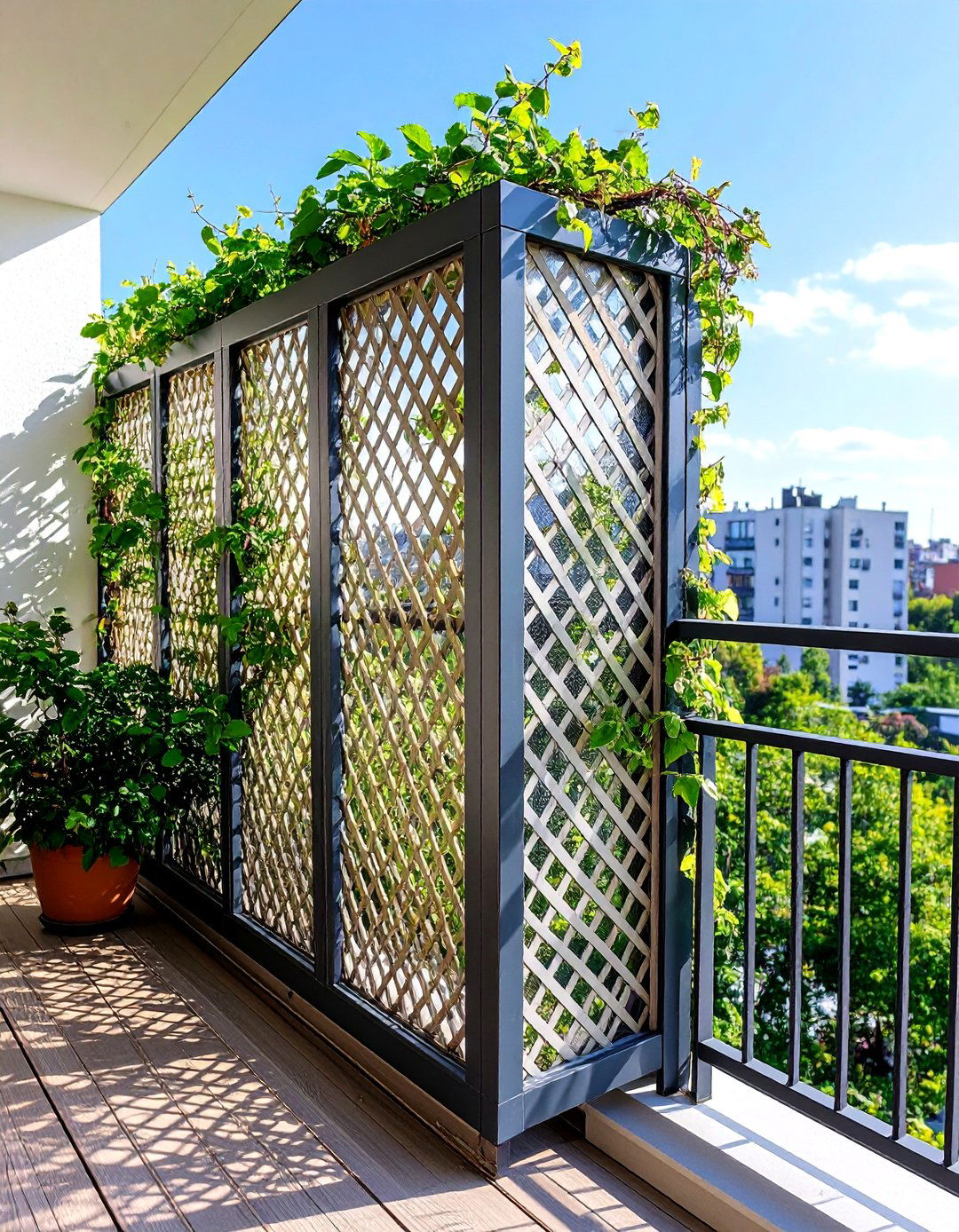



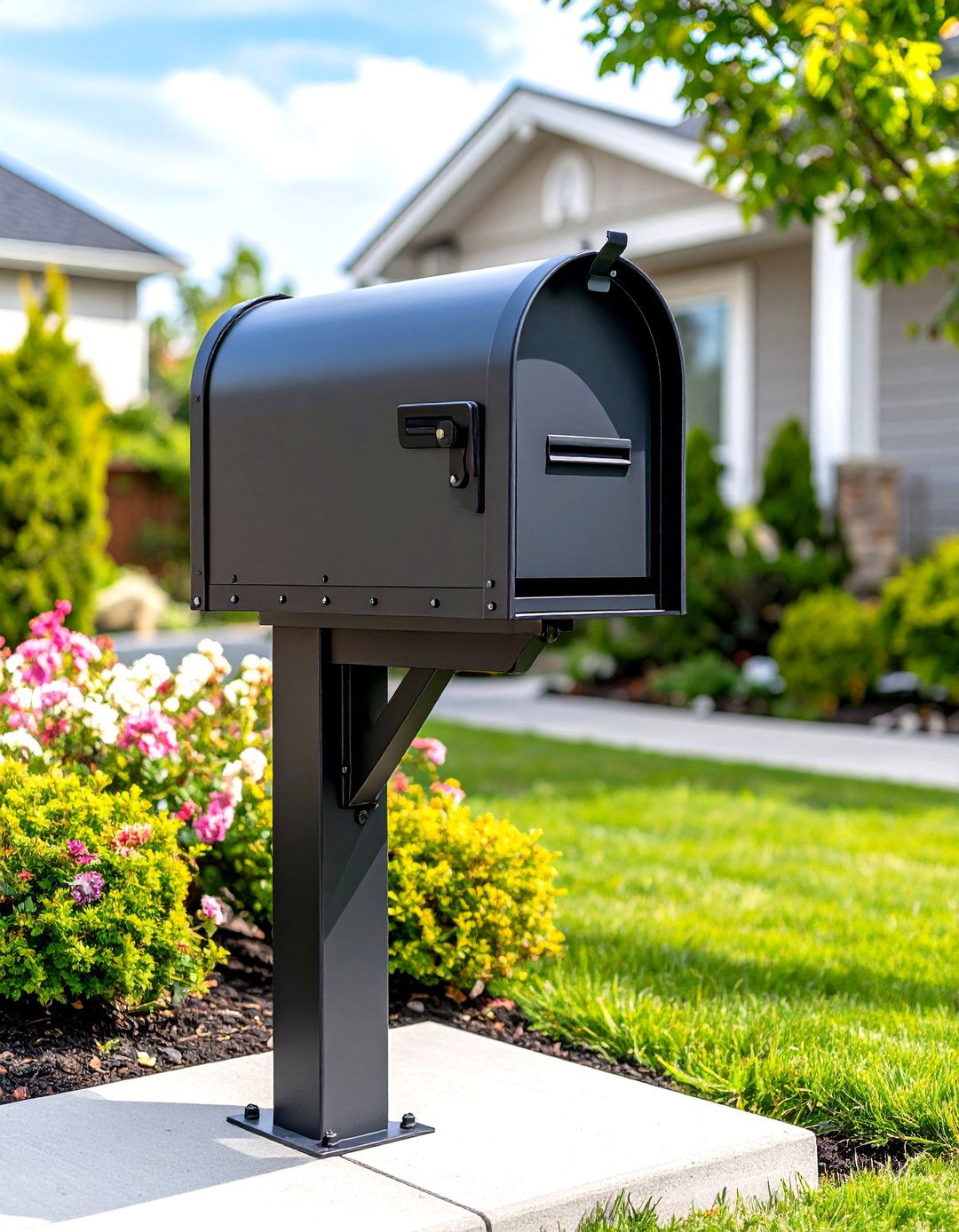
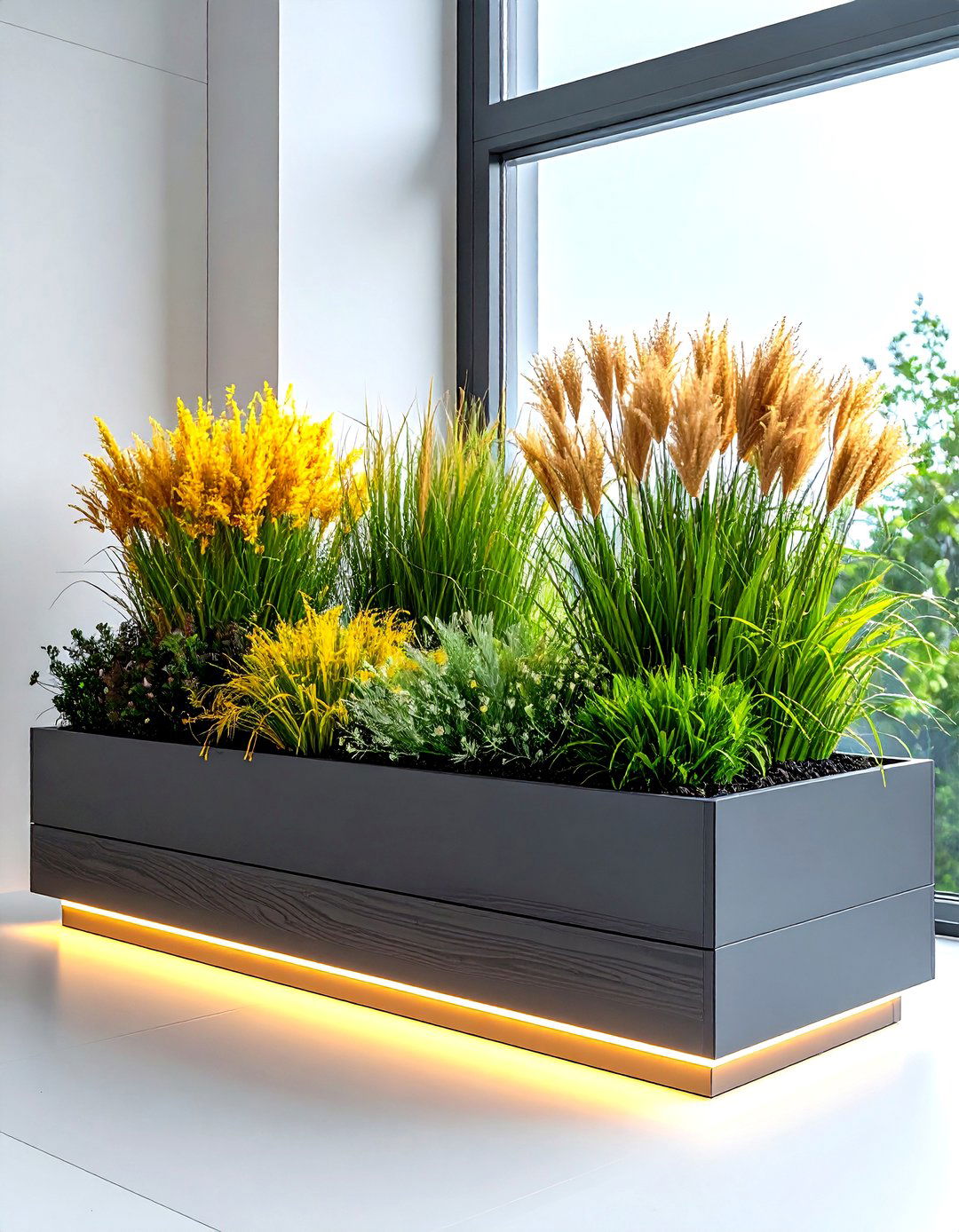
Leave a Reply